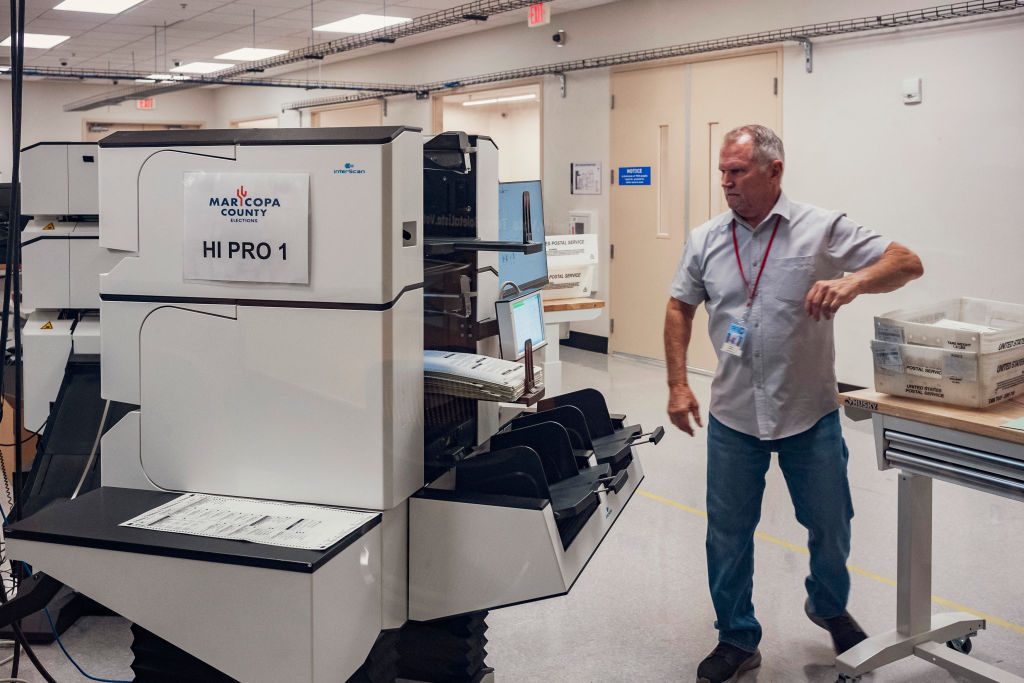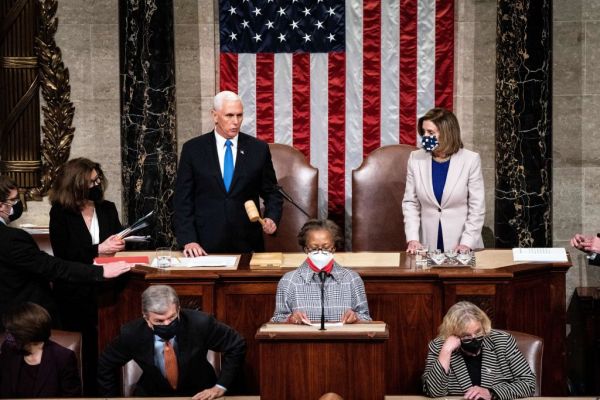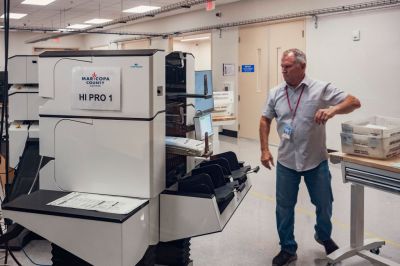
A wether is to sheep as a gelding is to horses: A male who has been, ahem, modified before reaching sexual maturity.
And if you put a bell on a wether, you can hear him coming when he leads the flock down from the pasture.
Like the farmer said: You can tell where this is going.
So what are the bellwether counties we should be listening for as the flock comes in on Election Day? Even the only modestly politically engaged will know some of these, others may be new to you, but each one has something important to tell us about the way the electorate shapes up.
And we could sure use some insights into a presidential race that very much seems like a jumble. Republican momentum already evident at the beginning of this week seemed to be confirmed when a new survey from CNBC’s primo pollsters gave former President Donald Trump the edge nationally by 2 points … exactly the same as the network’s poll in August. Oh. And the new poll has Trump doing worse in the swing states than the nation as a whole. Oh, dear.
So maybe the new poll from Monmouth University that shows Vice President Kamala Harris up nationally by 3 points or the tracking poll from TIPP that shows Harris retaking the lead after a brief dip are where it's at. But do we really think Harris is doing better in Georgia, a mostly Republican state, than in Pennsylvania, a mostly Democratic one?
The good news here is that this seems like a pretty typical election. At this point in 2012, the last election before the Trump era, high-quality polls showed challenger Mitt Romney in the lead, while others showed incumbent Barack Obama barely ahead. Obama went on to win nationally by almost 4 points and take every swing state other than North Carolina.
That didn’t make those polls “right” or “wrong.” They all showed a close race where the breeze blew one candidate into a clear victory. This year, the polls are much more stable than they were in 2012, but it’s feeling like the same kind of race: A small but distinct advantage early for one party, a late surge for the party out of power, and then we wait to see which party’s lower propensity voters turn out in greater numbers.
This is looking like a race that will be decided not by whose base shows up—we have every reason to think that both parties are FULLY engaged—but by which base’s voters drag their parents, cousins, step-aunts, and Amazon delivery drivers to the polls.
We stick with the advice of the great Kristen Soltis Anderson: Just watch the averages. But what do you do in a case like we have this week when the averages say the race is very, very close?
And I certainly agree with what Nate Silver says here: “While the polls could be wrong again — and in fact, they probably will be wrong to some degree — it’s extremely hard to predict the direction of the error. Empirically, there’s basically no correlation in polling error from one cycle to the next one.”
So we have a very close race with a high probability of substantial polling error, but we don’t know in which direction. Fun …
If polls have taken us pretty much as far as they can in predicting where the race will end up, where shall we turn? To the belled wethers, of course!
Below you’ll find our collection of counties, one from each of the seven swing states, that tell a different story about the election. These are places to look if you’re looking for clues on (or after) election night.
The counties below are not ones that will mirror the final results in their states, nor are they always the “must win” counties for their states, nor are they all swing counties that switched parties between 2016 and 2020.
But they are all places that provide a valuable window into how key constituencies are going to vote.
Maricopa County, Arizona
Phoenix and its suburbs comprise the vast majority of Arizona’s electorate. A clash of affluent, older voters and younger, largely Hispanic voters was decided for many years in Republicans’ favor, but when suburbanites started defecting from the GOP in 2020 it cost them the Grand Canyon State.
- 2020 presidential results: Trump 48.0% – Biden 50.1% (Biden +2.1)
- 2016 presidential results: Trump 47.7% – Clinton 44.8% (Trump +2.9)
- Non-Hispanic white: 53.2%
- Black: 6.9%
- Hispanic: 31.4%
- Bachelor’s degree or higher: 35%
- Median household income: $80,675
Washoe County, Nevada
Reno may be the other city in Nevada, but it and its county make a better place for race watchers than big, messy Las Vegas and Clark County to the south. Note well that both Trump and his Democratic opponent got higher vote shares in 2020. That’s reflective of the way the partisan disruption of 2016 has faded and partisans are getting back in their lanes.
- 2020 presidential results: Trump 46.3% – Biden 50.8% (Biden +4.5)
- 2016 presidential results: Trump 45.1% – Clinton 46.4% (Clinton +1.3)
- Non-Hispanic white: 59.8%
- Black: 3.1%
- Hispanic: 26.5%
- Bachelor’s degree or higher: 32.5%
- Median household income: $81,531
Ozaukee County, Wisconsin
Affluent, educated, and very nice, the suburbs north of Milwaukee represent the core of Democrats' effort to disrupt the typical Republican map. This is not a place that Harris will win, but if she does even as well as Biden did, Wisconsin will stay blue. If the Liz Cheney gambit has come up short, we will see it here.
- 2020 presidential results: Trump 55.2% – Biden 43.1% (Trump +12.1)
- 2016 presidential results: Trump 55.8% – Clinton 37.0% (Trump +18.8)
- Non-Hispanic white: 89.8%
- Black: 2.0%
- Hispanic: 3.9%
- Bachelor’s degree or higher: 49.8%
- Median household income: $92,258
Kent County, Michigan
A true swing county in a swing state, Gerald Ford’s hometown of Grand Rapids was once a Republican stronghold, but has been indicative of the GOP’s struggles in the Trump era. In 2020, Kent County switched from red to blue on the presidential level, even as Republican Senate nominee John James carried it. This year, watch for a gap between Republican Senate nominee Mike Rogers and Trump here.
- 2020 presidential results: Trump 45.8% – Biden 51.9% (Biden +6.1)
- 2016 presidential results: Trump 47.7% – Clinton 44.6% (Trump +3.1)
- Non-Hispanic white: 71.9%
- Black: 10.9%
- Hispanic: 11.7%
- Bachelor’s degree or higher: 38.6%
- Median household income: $76,274
Westmoreland County, Pennsylvania
Exurban Pittsburgh is Trump country if anyplace in the nation qualifies. Not far from the scene of the assassination attempt that almost took his life, this is hallowed ground for the MAGA movement. Here we will be watching for any changes in turnout or vote share for the red team. Working class and overwhelmingly white, this should be a very useful bellwether for the Trump base.
- 2020 presidential results: Trump 63.5% – Biden 35.2% (Trump +28.3)
- 2016 presidential results: Trump 63.5% – Clinton 32.5% (Trump 31.0)
- Non-Hispanic white: 92.6%
- Black: 3.0%
- Hispanic: 1.6%
- Bachelor’s degree or higher: 31.2%
- Median household income: $69,454
Nash County, North Carolina
What about Harris’ base? Check out Rocky Mount and Nash County, where black voters make the difference for Democrats. Democratic fears about black turnout and Harris’ underperformance of Biden in pre-election polls will be revealed clearly in this working class county.
- 2020 presidential results: Trump 49.4% – Biden 49.6% (Biden +0.2)
- 2016 presidential results: Trump 48.9% – Clinton 48.8% (Trump +1.1)
- Non-Hispanic white: 46.8%
- Black: 42.1%
- Hispanic: 8.4%
- Bachelor’s degree or higher: 21.9%
- Median household income: $56,770
Forsyth County, Georgia
We spent 2020 obsessing over Atlanta’s suburban counties. This year it’s time to look further afield to ruby-red exurban counties like Forsyth. Wealthy and well-educated, Forsyth swung a whopping 13.7 points left in 2020 as Biden became the first Democrat since Jimmy Carter to break 30 percent. Harris will hope she can keep eating into Trump’s raw-vote margin here as she tries to keep Georgia blue.
- 2020 presidential results: Trump 65.8% – Biden 32.6% (Trump +33.2)
- 2016 presidential results: Trump 70.6% – Clinton 23.7% (Trump +46.9)
- Non-Hispanic white: 61.6%
- Black: 4.9%
- Hispanic: 10.0%
- Asian: 21.8%
- Bachelor’s degree or higher: 55.1%
- Median household income: $134,821
Holy croakano! We welcome your feedback, so please email us with your tips, corrections, reactions, amplifications, etc. at STIREWALTISMS@THEDISPATCH.COM. If you’d like to be considered for publication, please include your real name and hometown. If you don’t want your comments to be made public, please specify.
STATSHOT
General Election
Kamala Harris: 46.8% (↓ 2.4 points from last week)
Donald Trump: 45.8% (↓ 1.6)
[Average includes: TIPP: Trump 47% - Harris 49%; NYT/Siena: Trump 47% - Harris 46%; CNN: Trump 47% - Harris 47%; WSJ: Trump 47% - Harris 45%; Monmouth: Trump 44% - Harris 47%]
Generic Ballot
Democrats: 46.4% (↓ 2.0 points from last week)
Republicans: 46.8% (no change)
[Average includes: NYT/Siena: 48% Democrats - 48% Republicans; CNN: 45% Democrats - 47% Republicans; WSJ: 45% Democrats - 49% Republicans; Monmouth: 47% Democrats - 45% Republicans; Suffolk/USA Today: 47% Democrats - 45% Republicans]
TIME OUT: AN ESTATE SALE, BUT ONLY HER CAREER IS DEAD
Washington Post: “Rooms on three floors of the townhouse brimmed with potential purchases as shoppers buzzed around [the estate sale] trying on items. … Display cases housed gold, silver and turquoise jewelry. In the center of the room, a table exhibited Faberge and Waterford crystal. … In the case of this estate sale, ‘since the listing said, “Congresswoman,” I just kind of had an idea of what it would be like,’ [Maddy Brannon] said. ‘And then when I went to the sale, I was like, wow, this is totally not what I was expecting.’ … She is referring to Corrine Brown, a Democrat who represented the Jacksonville, Fla., region in the U.S. House for nearly a quarter-century. Brown was one of the first Black lawmakers sent to Congress from Florida after Reconstruction. … However, her career never recovered from the federal indictment she faced in July 2016 related to her education nonprofit. She stood accused of using the charity as a slush fund for a life of opulence. … Without details about Brown’s biography, attendees at the estate sale were left to imagine the bags’ and baubles’ past lives.”
INDEPENDENTS SCRAMBLE NEVADA PRESIDENTIAL RACE
Politico: “Nevada’s diverse, working-class and highly transient electorate — difficult to model and even harder to poll — has long confounded Washington’s political class. … Changes to the state’s voter registration process in the state and broader frustrations with the two-party system have over the last four years sparked an explosion in the ranks of registered independents, who now outnumber both Democrats and Republicans here. And a confluence of factors that make those voters difficult to find and poll have left strategists more flummoxed than usual about which way the state is likely to swing. … Targeting and modeling built on swaths of voter data have helped both Democrats and Republicans mitigate uncertainty caused by the boom in what Nevada refers to as nonpartisan voters. But because this is the first presidential election with so many of them, strategists in both parties concede their plans are based on what amounts to a highly educated guess.”
Trump ground game operation littered with ‘fraudulent’ canvassers: Guardian: “Revealed: Trump ground game in key states flagged as potentially fake
Data suggests canvassers linked to Elon Musk’s America Pac falsely claimed to have visited homes of potential voters. … Leaked America Pac data obtained by the Guardian shows that roughly 24% of the door-knocks in Arizona and 25% of the door-knocks in Nevada this week were flagged under its internal ‘unusual survey logs’, a metric used to determine faked doors. … The extent of the flagged doors in America Pac’s operation underscores the risk of outsourcing a ground-game program, where paid canvassers are typically not as invested in their candidate’s victory compared with volunteers or campaign staff. … America Pac denied it was experiencing that level of actual fraud in Arizona and Nevada and declined to comment.”
As campaign closes, Harris can’t ditch her boss: Wall Street Journal: “Three months after she replaced President Biden atop the Democratic ticket, Harris has struggled to explain how she would differ from him and their unpopular administration—and voters have noticed. … A new Wall Street Journal poll finds that a majority of voters, 54%, say she would largely continue Biden’s approach and policies, while 41% said she would bring her own fresh ideas and new leadership to the White House. The image of Harris as staying on Biden’s course was even more prevalent among the small portion of voters considered persuadable. … Asked which candidate would bring about needed change, the national survey found 49% naming Trump and 40% picking Harris. … [The polling] also raises the question of whether she needs to take more steps to separate herself from the president.”
Why the polls were wrong in 2020—and what’s different this year: New York Times: “Although they have countless hypotheses, I’d broadly say there are two not-entirely-mutually-exclusive theories for the polling misfires in 2016 and 2020. … Let’s call the first approach the unified theory. … This theory holds that pollsters simply can’t reach enough of the least politically engaged voters — and these voters overwhelmingly back Mr. Trump. … If you’re a liberal reader of this newsletter, this theory may send a shiver down your spine. … The second theory is not so unified. Let’s call it the patchwork theory. … In this tale, the polling errors in 2016 and 2020 may look similar, but they were actually very different. … When it comes to 2020, the patchwork theory ultimately leans a lot on one explanation: the pandemic. … The (overly simplistic but plausible) story here is that Democrats were free and available to take surveys all day, lonely and grateful to speak with a human, enraged by Mr. Trump and the pandemic, all while Republicans tended to be out living their lives.”
INDEPENDENT OSBORN THREATENS UPSET IN NEBRASKA
New York Times: “The populist appeal — in which members of both major political parties are cast as feline villains and [Dan Osborn] as one of the preyed-upon rodents — has helped propel his challenge to Senator Deb Fischer. … Nebraska has thrown Republicans for a loop. Mr. Osborn’s dark-horse, grass-roots campaign has transformed what was expected to be a sleepy race into a late-breaking and high-stakes clash that has forced Ms. Fischer and her allies to invest millions of dollars to avoid an upset. … When he jumped into the political fray last September, Mr. Osborn had little name recognition and even less money, and pundits and the news media had largely written off the race. But funding is no longer a barrier; his campaign hauled in close to $3.3 million last quarter. … Two recent nonaffiliated surveys showed Mr. Osborn within a few points of Ms. Fischer.”
GOP drops $6 million into Nevada after encouraging early vote: NBC News: “Republicans are making a last-ditch effort to flip Nevada's Senate seat, optimistic that a strong performance from former President Donald Trump in the state could boost Republican Senate candidate Sam Brown. Senate Leadership Fund, the main GOP super PAC involved in Senate races, is planning to spend $6.2 million on TV, radio and digital ads in Nevada. … It is the group's first spending in the state, marking a relatively late entry into the contest, which has been marked so far by a split between a competitive presidential race and a more comfortable position for Rosen in public polling. … Rosen and her Democratic allies have long outspent Republicans on the airwaves. Since Labor Day, Democrats have spent a combined $38.3 million on ads in Nevada, while Republicans have spent $27.6 million.”
Sherrod Brown launches final push for crossover support: Bloomberg: “The 71-year-old incumbent has a narrow edge in most polls. But in a state Trump is expected to win easily, Brown’s Republican challenger, car dealer and blockchain entrepreneur Bernie Moreno, has been gaining ground. … Brown is counting on his personal brand of supporting labor and opposing trade deals like Nafta decades before Trump entered politics and made protectionism popular again. … On the campaign trail, he rarely mentions Vice President Kamala Harris by name. Instead, he touts administration initiatives that benefited local residents. … That kind of bring-home-the-bacon politics used to help senators hold their seats even when voters in their states backed presidential candidates from opposing parties. … Brown still has the backing of Trump voters like Joanna Colucci, a Trumbull County government worker who praised him for fighting trade deals since the 1990s. … ‘I trust him. … Sherrod Brown has experience and this guy coming in, who knows what he’s going to do.’”
Choose Your News, Early Voting Edition:
Republicans elated at Nevada early voting figures—Nevada Independent
Democrats jubilate over Detroit turnout—WDIV
Team Trump “breathing easier” as early North Carolina data rolls in—Politico
Black share of early electorate in Georgia down so far compared to 2020—WJCL
Georgia and North Carolina smash early in-person voting records—Forbes
BRIEFLY
Dems hopeful about surprisingly close Indiana gubernatorial race—National Journal
Poll: Begich narrowly leads Peltola in ranked-choice Alaska—Politico
National Dems flood the airwaves in New Jersey battleground with last-minute $4 million spending spree—New Jersey Globe
House Dems cancel ad buys in 10 districts as outlook in light blue seats improves—Politico
WITHIN EARSHOT: WIN SO MUCH, YOU’RE TIRED OF WINNING
“We are not in a position to win the White House. But we do have a real opportunity to win something historic. We could deny Kamala Harris the state of Michigan.” —Kshama Sawant, a leader of the Abandon Harris movement, speaks to a crowd at an Arab American cultural center in Dearborn, Michigan.
MAILBAG
“Two weeks ago you said on your Sunday show that you were likely to know by 9:30 election night who the winner was in the presidential election. I have held onto that statement like a comforting blanket. I worry that your latest statement putting Election Week in parentheses with a question mark might be a backing off from your earlier statement, which is increasing my stress levels. Any possibility that I am reading too much into your comment today?”—Jack Goldberg, Tampa, Florida
Mr. Goldberg,
I’m not retreating, but I am certainly open to the possibility that I might be wrong and am preparing myself and my sleep schedule accordingly.
And I should also be clear about what I was talking about. I think the chances that we will have called enough races to declare a winner by that point are very, very low. The kind of polling error that would be necessary to have a race that’s this close turn out to be a relative landslide is not impossible, but quite unlikely.
Yes, if Harris has been dramatically understated in the polls by the kind of margin that Trump was four years ago, we could see things fall quickly into place. But I’m sure not betting on that.
What I mean about the 9:30 mark is that by then we will have a very good idea how key precincts are trending and enough raw votes counted to start making some assumptions about how big the polling error is and which direction it’s heading.
Polls close in Georgia at 7 p.m. ET, 7:30 in North Carolina, 8 p.m. in Pennsylvania and 9 p.m. in Michigan, Wisconsin, and Arizona. By 9:30 or so, we will have loads and loads of returns to tell us how various voters are breaking, and, more importantly, what turnout is looking like for different groups.
If you hear me saying that Georgia and North Carolina are very close or even that it looks like Harris is clinging to a slim advantage, you can pretty well figure that she’s on her way to winning. Conversely, if Trump is doing the same in Pennsylvania or Wisconsin, and holding up well in the South, then the red team is on march.
There are basically three scenarios: 1) The polling is really good, the race is actually this close, and we are in for a days-long ordeal of vote counting with much uncertainty; 2) The polling has understated Harris and we have a call by, say, midnight; or 3) The polling has understated Trump more, and it goes on into the wee hours but we’ve known for some time where it was going to end up.
There is the less likely scenario in which Trump is massively understated and sweeps all seven swing states in decisive fashion, but just given how much more difficult the map is for Republicans—Harris can win simply by holding the traditionally blue states but Trump needs a flip to win—and how much longer it takes to count ballots in the dense urban areas where Democrats dominate, even a substantial Trump overperformance would take a while to sort out.
What I expect to know by 9:30-ish is which of those scenarios we’re dealing with. If I say that I’m going to start eating carbs, you’ll know I expect we’re almost done. If it’s straight bags of meat, I’m settling in for the long haul.
Exhausted in advance,
c
“I’m a fan of your newsletter, the Wretches and any time you’re a guest of Jonah’s. I’m sure I’d be a fan of your Sunday show too, but I don’t have cable. I catch many of the Sunday shows on the C-SPAN radio broadcast on Sunday afternoons. When can I look forward to The Hill Sunday being added to that lineup? I hope you and your people are having discussions about this with C-SPAN. Best regards and thank you for your ever-cheerful outlook and eloquent, colorful turn of phrase.”—Gwen Stokls, Alexandria, Virginia
Ms. Stokls,
I’m a little cringey about self-promotion, but, seven months in, I’m actually really getting to like doing my TV show. We have a great team and I’m particularly proud of our journalist panels. All hacks, no flacks.
So, here’s the good news for cord cutters: In addition to our 10 a.m. ET slot on NewsNation, you can stream live on many platforms. We’re also available over the airwaves. In your market, the show re-airs at 1 p.m. on WDCW. Others can find their station and broadcast times here.
The network does post some clips here, and, each week, I ask my Twitter wrangler to post one clip of some content that might be of interest to like-minded weirdos, such as this banger from the great Kevin Williamson.
But, if you think that C-SPAN really should be broadcasting the show on radio, please feel free to call them at (202) 737-3220 or email the network.
Shamelessly,
c
You should email us! Write to STIREWALTISMS@THEDISPATCH.COM with your tips, kudos, criticisms, insights, rediscovered words, wonderful names, recipes, and, always, good jokes. Please include your real name—at least first and last—and hometown. Make sure to let us know in the email if you want to keep your submission private. My colleague, the psephological Nate Moore, and I will look for your emails and then share the most interesting ones and my responses here. Clickety clack!
CUTLINE CONTEST: MUGATU BE KIDDING ME

The winner this week, and the final entrant in the October Cutline Contest is so hot right now with a Zoolander joke for this photo of House Speaker Mike Johnson and House Minority Leader Hakeem Jeffries. I know, I know … I shouldn’t be such a sucker for dated pop cultural references, and yet, here we are again:
“Mike Johnson practices ‘Red Steel,’ his come hither pose to woo suburban women to vote Republican.”—Tripp Whitbeck, Arlington, Virginia
Winner, Nyuck, Nyuck, Nyuck Division:
“Hakeem, is that an emerging Democratic majority or are you just happy to see me?”—Crag Berry, Frankfort, Illinois
Winner, Waddle Harder Division:
“Speaker Mike Johnson wins 2024 Congressional Speed Walking Competition in photo finish.”—Alex Forney, Chattanooga, Tennessee
Winner, Uniformity Division:
“Speaker Mike Johnson muses, 'I wish I could sometimes wear a tie without red in it.”—Linda McKee, DuBois, Pennsylvania
Winner, Spotify All Stars Division:
“I'm doing the dance exactly the way Donald taught it to me."—David Landry, Lynnfield, Massachusetts
Winner, A Good Plan Violently Executed Now Division:
“Patton had the right idea. Settle it right here. Elbow to the gut. Upper cut. Badda bing. I’m still speaker.”—Richard Kennedy, Ferndale, Michigan
Winner, DMV Division:
“For the 2025 season, replacing the Presidents Race—a team tradition since July 21, 2006—the Washington Nationals middle-of-the-fourth-inning mascot run will feature the actual speaker of the House, the minority leader, and two players to be named later. Shown here are the contestants in training.”—Allen Mabry, Dallas, Texas
Winner, Full Frontal Division:
“Mike Johnson is relieved to see a Democrat walking behind him—the party less likely to stab him in the back.”—Will Bates, St. Louis, Missouri
Winner, Let The Big Dog Eat Division:
“Have I mentioned the time I played 18 with Arnold Palmer?”—Bob Goldman, Gilroy, California
October Winners
This week’s movie quote winner only compounds October’s bias toward cinematic gags, since our monthly winner is Tim Maloney of St. Louis, who takes the prize for his cutline for this photo of Ohio Republican Senate candidate Bernie Moreno, glimpsed through closing elevator doors: “Kay, never ask me about my business.”
Not only does Mr. Maloney get a ticket to the big annual ham prize to be awarded at the end of December, but he takes this week’s emolument: A button from Mario Cuomo’s unsuccessful 1977 race for New York mayor. By the time Cuomo, seen as a serious, progressive policy wonk, was making his bid, the cultural effects of two hugely successful Godfather movies that decade no doubt had implications for a candidate who was seeking to be the first Italian American elected to a full term as the city’s mayor since Fiorello La Guardia in 1941.
Cuomo bounced back after his loss to Ed Koch and went on to the lieutenant governorship the next year before winning three terms as the Empire State’s governor, the first Italian American to win that job, and the only one until his son followed suit in 2010.
Please send us your mailing address, Mr. Maloney, so we can send your winnings along!
‘JABBA THE HUTT WITH A SPRAY TAN’
The Atlantic: “There are two Michael Jordans, both widely regarded as the Greatest of All Time. One is an NBA legend. The other is a pumpkin. In 2023, the 2,749-pound Goliath set the world record for heaviest pumpkin. … Like all giant pumpkins, its flesh was warped by all that mass—sort of like Jabba the Hutt with a spray tan. It is hard to imagine how a pumpkin could get any bigger. … For champion growers, there’s only one thing to do next: try to break 3,000. … Virtually all of today’s champions trace their lineage to Dill’s Atlantic Giant, a variety bred in the 1970s by a Canadian grower named Howard Dill. … All of the experts I spoke with believe that 3,000 pounds is within reach. … Giant pumpkins…have a singular purpose: to become as heavy as possible. They don’t have to be beautiful, taste good, or withstand transport, because they are not food. … Even the most majestic of pumpkins inevitably meets the same fate: devoured by livestock, and returned to the earth.”






Please note that we at The Dispatch hold ourselves, our work, and our commenters to a higher standard than other places on the internet. We welcome comments that foster genuine debate or discussion—including comments critical of us or our work—but responses that include ad hominem attacks on fellow Dispatch members or are intended to stoke fear and anger may be moderated.
With your membership, you only have the ability to comment on The Morning Dispatch articles. Consider upgrading to join the conversation everywhere.